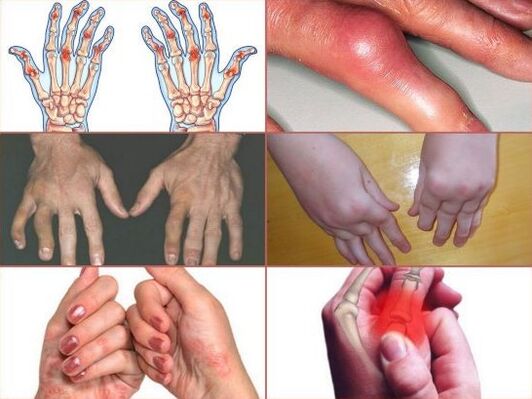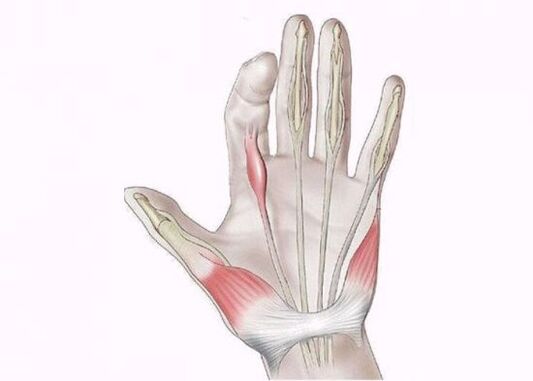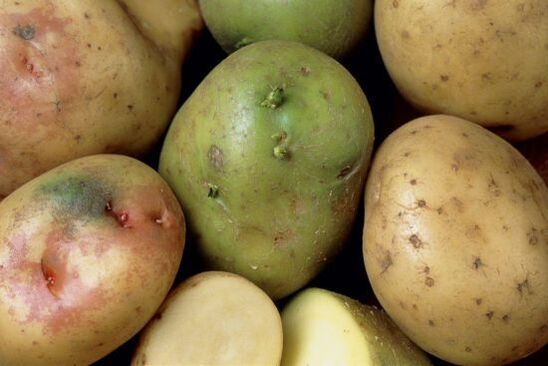
In the structure of the hand, it is the most complex part of the upper limb. It consists of many bones that are tightly grouped together. The bones are connected through 30 different joints - interphalangeal, metacarpophalangeal, carpometacarpal and radiocarpal.
According to statistics, hands are injured much more often than any other part of the body. According to various sources, various injuries account for 30-50% of injuries to the musculoskeletal system and are not reduced.
Therefore, trauma is the most important cause of pain in the fingers of the hands. In second place in terms of prevalence are connective tissue diseases - rheumatoid arthritis, systemic scleroderma and lupus erythematosus, psoriasis. More rarely, pain in the joints of the fingers is caused by a violation of the metabolic processes of gout, osteoarthritis.
Symptoms
Signs of non-traumatic injuries that may indicate the presence of joint pathology include:
- pain syndrome that is constant or wavy;
- pain when pressing and bending fingers;
- swelling and redness of the skin above the joints;
- stiffness, stiffness while moving;
- deterioration of fine motor skills;
- squeaking, crackling and cracking during finger bending;
- formation of subcutaneous nodules, non-contact;
- thickening of the skin at the folds;
- changes in joint configuration;
- increase in body temperature.
Rheumatoid arthritis
Rheumatoid arthritis most commonly affects the fingers and the right and left hands at the same time. This systemic disease is characterized by a failure of the immune system in which T lymphocytes begin to attack their own cells. The cells of the synovial membrane lining the inner capsule actively produce rheumatic factors: abnormal antibodies are protective protein molecules.
Rheumatoid factors then enter the bloodstream and bind to normal antibodies. As a result, immune complexes are formed that settle in the blood vessels and tissues. They are absorbed by the cells of the immune system - neutrophils and phagocytes - and release substances that damage the surrounding structures.
This is known to cause inflammation in rheumatoid arthritis. However, scientists have not been able to determine the cause of this process. Recent research in this area has shown that cytokines, the signaling immune cells, are responsible for connective tissue damage. Japanese experts have concluded that studying this cell type will help you find an effective treatment method.
In rheumatoid arthritis, either finger can hurt - the index, middle, ring, or little finger, but the lesion will always be bilateral. If one or more fingers on the left hand get sick, the same fingers on the right hand start to hurt almost immediately.
In the area of the joints, the flames swell and turn red, they do not bend well due to the accumulation of fluid, especially in the morning. Morning stiffness can take up to 1 hour. Over time, the progression of arthritis leads to a fibrous replacement of the smooth cartilage tissue, which disrupts the free movement of bones in the joint.
Gradually, the joints become deformed, and the pain intensifies due to a change in the position of the joint elements. In the long course of the disease, small painless formations appear near the joints in the back of the hand - rheumatic nodules.
Psoriatic arthritis
The symptoms of this disease may resemble rheumatoid arthritis and may occur in the background of a dermatological pathology called psoriasis. In the vast majority of cases, rashes appear first, followed by pain in the joints of the fingers over time.
Simultaneous onset of skin and joint lesions is possible, with joints starting to hurt in less than 20 out of 100 patients. Why psoriasis occurs is not known. Presumably, it can be provoked by genetic predisposition, immune system dysfunction, and infections. The mean age of the patients was 40 years.

Psoriatic arthritis, like rheumatoid arthritis, can start with general weakness and malaise, or suddenly present with a sharp pain sensation. Not only the fingers are affected, but also the small joints of the feet, knees and shoulders. Participation in the pathological process can be both one-sided and symmetrical.
Pain syndrome is most pronounced at night and at rest. There is stiffness in the morning, during the day and with movement the pain subsides. Most often, there is a lesion on one side - the left or right side - and it usually hurts not one but 2-4 joints (oligo-arthritis).
After a long rest, the fingers become very swollen and sausage-like, the tendons of the flexor muscles become inflamed, the skin above the joints gets a purple-bluish tinge. The following symptoms indicate the presence of psoriasis and psoriatic arthritis:
- red or pink scaly patches on the head, elbows, knees and thighs - they may be unique or cover a large area of skin;
- characteristic pits on the skin of the hand, similar to smallpox, pigment spots on the fingers or toes;
- psoriatic plaques are hyperemic, edematous, and pruritus;
- joint pain is constant and does not go away during the day;
- hand mobility and functionality are significantly reduced.
The arthropathic form of psoriasis is one of the most severe. In general, deformation of the joints is not observed, but if this occurs, fusion of the joint surfaces of the bones (ankylosis) cannot be ruled out.
The danger of this disease is that the large joints and spine are gradually involved in the pathological process. Osteoporosis develops and the joints are destroyed, so psoriasis often leads to disability.
Osteoarthritis
In arthrosis, the process of cartilage tissue covering the joint surface of the bones is interrupted. This is facilitated by both external and internal factors - injuries, high physical activity, hereditary predisposition and metabolic disorders.
Depending on the cause, arthrosis can be primary and secondary to underlying endocrine or metabolic disease. Arthrosis most commonly affects the large joints of the lower extremities - the knees, hips and ankles - as they bear the main load when walking and standing. The upper limbs are much less commonly affected.
If the fingers ache due to prolonged physical exertion and the pain disappears after rest, the development of arthrosis is not ruled out.
Over time, other symptoms appear:
- increased pain when clenched or fingers tightened;
- an increase in the size of the patient's joint;
- stiffness in the morning, which requires the "development" of the fingers for 10-15 minutes or more;
- characteristic cracking of the fingers.
Osteoarthritis develops slowly and does not cause much concern for years or even decades. In some cases, however, a rapid increase in symptoms and a sharp deterioration in the condition are observed. If at first the pain only occurs during exertion, it will not go away later after rest.
Due to the marginal growths of the bones that make up the joints, characteristic pineal gland formations appear. Closer to the palm, Bouchard nodules form in the proximal phalangeal joints. Heberden nodules are located near the distal interphalangeal joints near the nails.
Stenotic ligamentitis
Narrowing of the ligament affects the ligament of the hand and manifests as a blockage of one of the fingers in a bending or stretching position. The pathological process is caused by overload or excessive pressure on the ligament area, so the disease occurs among manual workers - builders, welders, seamstresses and kitchen workers. In children, stenosis ligamentitis is extremely rare and only affects the thumb.

The main symptom of the disease is a "jump" of the finger during extension, accompanied by a click. In the future, the "pimple" will disappear and the finger will remain motionless, turning into a bend or extensor contracture.
In the early stages, pain occurs when you press the palm at the base of the finger and have difficulty bending / stretching, especially in the morning. In the case of prolonged tendonitis, you can only move your finger with the other hand, and after a "pimple, " there is pain that spreads not only to the palm but also to the forearm.
Which doctor to go to
If you have finger pain, you can first contact a therapist who will refer you to a close specialist, such as a traumatologist, rheumatologist, hematologist, neurologist or surgeon, if necessary. Clinical, radiological, and laboratory research methods are used for diagnosis.
A physical examination (history) and a physical examination are performed to find out the cause of the pain, followed by an X-ray or tomography, blood and urine tests.
Treatment
The method of treatment and what to do next depends on the results of the test. Task 1 is to relieve pain and inflammation: medicines from the NSAID group are prescribed for this - non-steroidal anti-inflammatory drugs. The selective effects of new generation NSAIDs are now being used more and more.
Selective NSAIDs have a selective effect and are less toxic to the body and can be taken for long periods of time. If the pain syndrome is moderate or mild, topical agents are used - anti-inflammatory ointments and gels.
The treatment of rheumatoid arthritis involves essential and biological products, steroid hormones. These drugs suppress the immune system, thereby reducing the intensity of the inflammatory process.
The same immunosuppressive drugs are prescribed if the joints are painful in the background of psoriatic arthritis. Methods such as plasmapheresis, hemosorption, and photochemotherapy are used to reduce disease activity, prolong remission periods, and shorten the duration of medication.
The way to treat arthrosis depends on the stage of the disease. In stages 1-2, the use of chondroprotectors can significantly slow cartilage destruction. Physiotherapy is effective, which enhances the effect of drugs and stimulates healing processes.
The following may be prescribed for the treatment of arthrosis:
- magnetotherapy;
- electrophoresis;
- laser;
- ultrasound;
- cryotherapy - contact of joints with liquid nitrogen;
- balneotherapy - baths with mineral water;
- hirudotherapy - substances that promote cartilage regeneration (hirudin, vitamins and hormones) enter the joint during treatment with leeches.
The therapeutic tactic for stenosis ligamentitis is determined by the stage, the presence of provocative factors, and the age of the patient. If damage to the straps is minimal, it is recommended to reduce the strain on the hand and, if necessary, secure the hand with an orthosis or rail. In case of pain, anti-inflammatory drugs and hyaluronidase electrophoresis are prescribed.
The treatment of the second stage begins with conservative methods. The lack of effect for several months suggests surgery to cut the damaged ligament. Conservative therapy is extremely rare in patients with stage three, and in most cases surgery is performed as planned.
Reference: Due to the high risk of recurrence, it is very important to change professions if it involves a strain on the hand.
Folk remedies
Tools made according to folk recipes may not be the main method of treatment as they are not effective enough. However, as adjunctive therapy, such drugs help relieve pain and enhance the effects of the drugs.

Mix a few bay leaves with juniper needles, add a little butter and massage your hands with the resulting ointment.
You can make a compress of crushed chalk, kefir, fermented baked milk or boiled oatmeal at night.
For compaction, green potatoes are used, which are chopped directly into the skin in a meat grinder or grater. Then dip the mashed potatoes in hot water and heat to 39-40 ° C. Then put it in a canvas bag and apply it to the sore joints for half an hour. The procedure can be performed several times a day.
Paraffin applications relieve pain well by placing our hands in melted paraffin for 10 minutes and then keeping it in any herbal decoction for 15-20 minutes. You cannot be afraid of burns, as paraffin melts at a temperature no higher than 65 °. 2-3 applications per week are sufficient to achieve the effect.
A compress containing Bischofite accelerates tissue healing. Due to its composition, this natural mineral relieves pain and inflammation, restores joint mobility. Regular use of Bishofit maintains the tone of muscles and connective tissues.
We recommend a Bischofite compress as follows: warm the joints with a heating pad or keep in a warm bath, then rub the Bischofite previously diluted 1: 1 with water into the skin of the hands. Rubbing should be continued for a few minutes and then applied to the sore area with a cloth or gauze soaked in the solution. From the top, the compress is covered and insulated with polyethylene. Bischofite compresses are made at night, washing your hands thoroughly with warm water in the morning. The procedure is performed every other day for three weeks.
Reference: The Bischofite compress can be applied to up to three joints at a time.
The most important
To prevent or reduce the intensity of pain that has already appeared, the brushes should be kept warm and not subjected to hypothermia. Work that requires the same type of movement is best done intermittently, and gloves should be used when using vibrating equipment, and support the work brush with the other hand. When lifting and carrying heavy loads, the weight of the load should be evenly distributed on both limbs. You can also maintain joint health with proper nutrition, which should include foods containing calcium and omega-3 fatty acids.

















































